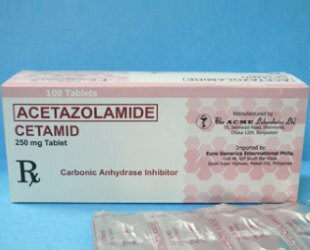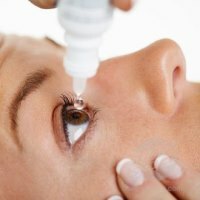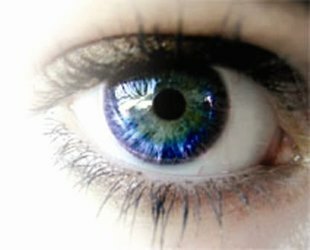
Pharmacological action of eye drops Acetazolamide
Acetazolamide is a special crystalline powder of white color, completely odorless. It practically does not dissolve in water, it dissolves easily in alkali solutions.
Pharmacological action - diuretic, inhibiting carbonic anhydrase, antiglaucoma and antiepileptic. Inhibition of the carbonic anhydrase of the entire ciliary body can lead to a gradual decrease in intraocular pressure, as well as a decrease in the secretion of aqueous humor.
- 1. Pharmacological action of eye drops Acetazolamide
- 2. Pharmacokinetics
- 3. Composition and form of release
- 4. Indications
- 5. Application rules for
- 6. Side effects of the drug Acetazolamide
- 7. Method of administration and dose
- 8Contraindications
- 9. Storage conditions
- 10. Average cost of the drug in Russia and Ukraine
- 11. Analogues
- 12. Reviews
A sharp decrease in the activity of the carbonic anhydrase in the brain causes a strong inhibition of paroxysmal raseries of neurons, as well as anti-epileptic activity.
In case of ingestion, the drug is well absorbed from the gastrointestinal tract. The drug reaches its maximum in blood after 2 hours. Then passes through the placenta, and then in small amounts passes into breast milk. It is not biotransformed at all. Excreted by the kidneys in a completely unchanged form. The total duration of the action is 12 hours.
In animal experimental studies, the drug exhibits embryotoxic and teratogenic effects after doses that are 10 times higher than the MPD.
Pharmacokinetics
After ingestion, the drug Acetazolamide from the gastrointestinal tract is perfectly absorbed.
Immediately after taking this drug in a total dose of 500 mg of active substance in general is only 12-27 μg / ml, and it is reached in 1-3 hours. The total detectable plasma concentration of acetazolamide is maintained for 24 hours after its application.
Mainly distributed in erythrocytes, muscles, kidneys, central nervous system and eyeball tissues. With plasma proteins binds to a high degree. Then it passes through the entire placenta, into the breast milk penetrates in fairly small amounts.

Note - the price of eye drops from conjunctivitis. Price overview in the CIS atecs.
In the article( tyts) all the analogues of clonidine.
Methods of treating scleritis!http: //moezrenie.com/bolezni/ zabolevaniya-sklery / sklerit-kharakteristika-bolezni.html
Composition and form of release
The preparation is of synthetic origin. The main active substance is acetazolamide. This drug is produced in tablets of 0.25 grams - packs of 24 pills.
Indications

This drug Acetazolamide is recommended for use in the following cases:
- with edematous syndrome of moderate and mild severity, together with alkalosis( as part of complex therapy for chronic cardiopulmonary insufficiency and heart failure);
- for glaucoma( primary and secondary, chronic open-angle, acute closed-angle - preoperative treatment for lowering intraocular pressure);
- with secondary glaucoma;
- for epilepsy;
- with intracranial hypertension;
- in acute altitude( mountain) disease( the drug reduces the total time of acclimatization, but its effect on all the symptoms of such a disease is expressed very slightly).
Rules for the use of
In the presence of edema of cardiac origin, take 1 tablet once a day, or with interruptions in several days, courses of 2-4 days after 1 day.
In case of more frequent use, the diuretic effect is significantly reduced, and the dose does not increase to the desired result.
Also, when glaucoma, you must take inside every other day, 1 tablet twice a day. In case of epilepsy, 2 tablets should be taken once a day.
Side effects of the drug Acetazolamide

In case of short-term use, side effects are most often not expressed.
When receiving, paresthesia was also noted( usually tingling sensation in the limbs): In the case of prolonged use, it is possible to develop metabolic acidosis or electrolyte imbalance. This is usually corrected by assigning sodium bicarbonate. In addition, there have been cases of transient myopia occurring after the withdrawal of this drug. Gastrointestinal tract - diarrhea, nausea and vomiting can occur. The use of acetazolamide can also cause fever, leukopenia, agranulocytosis, thrombolytic purpura, thrombocytopenia, aplastic anemia, rash, pancytopenia, urolithiasis, anaphylactic reactions, renal colic, crystalluria, urolithiasis, kidney damage, and bone marrow suppression. Much less marked was the onset of fulminant necrosis of the liver. Possible casuistic side effects: To be taken orally, only with glaucoma, to select the dose individually strictly depending on the obtained parameters of intraocular pressure. In case of epilepsy: The maximum diuretic effect can be achieved in the case of reception every other day. When mountain sickness is recommended to take a dose of 250 mg three times a day. During the treatment of this drug, especially the elderly, a special diet is recommended, very rich in potassium: beets, peas, beans, potatoes, carrots, beans, prunes, dried apricots, peanuts, oranges, bananas, peaches, raisins, oatmeal. Drug Acetazolamide is absolutely contraindicated to the following patients: Also not recommended for patients with liver cirrhosis, because all this can significantly increase the risk of hepatic encephalopathy. With increased sensitivity to various sulfonamides, severe side effects may develop: If suddenly there are any skin changes or changes in the blood picture, the medicine used should be urgently canceled. With prolonged use, it is mandatory to monitor the serum level of electrolytes, and also control the picture of peripheral blood. Preparation Acetazolamide, which is used in doses, is more than recommended, is not able to increase diuresis, and often only reduces it, however, at the same time, it increases drowsiness or paresthesia. In some circumstances, it is used in especially large doses together with other diuretics to ensure the most reliable diuresis in refractory heart failure. In addition to this, doctors do not recommend the use of this drug during the work of drivers of vehicles, as well as people whose profession is necessarily associated with increased attention. In the case of simultaneous use of acetazolamide with any anticholinesterase drugs in patients with myasthenia, muscle weakness is greatly enhanced. In case of simultaneous use, the risk of various toxic effects of ephedrine, salicylates, carbamazepine, digitalis preparations and nondepolarizing muscle relaxants increases. In the case of simultaneous administration of the drug with diuretics, theophylline potentiates some diuretic action. Simultaneous use of acetazolamide with lithium preparations increases the excretion of lithium in urine. In addition, a case of lithium intoxication after therapy with Acetazolamide has been described not later than 1 month. Joint use with ammonium chloride causes acidosis, and also weakens the effect of the action of acetazolamide( doctors do not recommend to apply at one time). Co-administration with acetazolamide significantly increases the clinical efficacy of the insulin substance and, of course, oral hypoglycemic agents. Simultaneous use of this drug with primidone is a risk of reducing the concentration of primidone in the blood serum and a reduction in the entire anticonvulsant action and marked osteomalacia. In addition to all of the above, there are also reports that with simultaneous use, the total concentration of cyclosporin substance that is capable of accompanying the kidneys with harmful toxic effects increases significantly and rapidly in blood plasma. Read on is a list of vitamins for eyes to improve vision. How to help the eyes? In the news( link) reviews about eye drops from redness and irritation. Description of the laser surgery clinic Sphere!http: //moezrenie.com/kliniki/ klinika-sovremennoj-lazernoj-meditsiny-sfera.html The drug Acetazolamide should be stored up to 5 years after manufacturing, in rooms at a temperature of 8-30 degrees Celsius. Immediately after opening the vial, it should be stored for 28 days and no more. The average cost of the drug Acetazolamide in Russia is 240 rubles, and in Ukraine the average price is 43 hryvnia. Excellent analogs of this drug are the following drugs: Basically, reviews about this drug are positive. Practically all the patients who used them were satisfied. Detailed reviews can be read at the end of the article.
Route of administration and dose
Special instructions
Contraindications

Precautions
Interaction with other drugs

Storage conditions

The average cost of the drug in Russia and Ukraine
Analogues
Reviews
